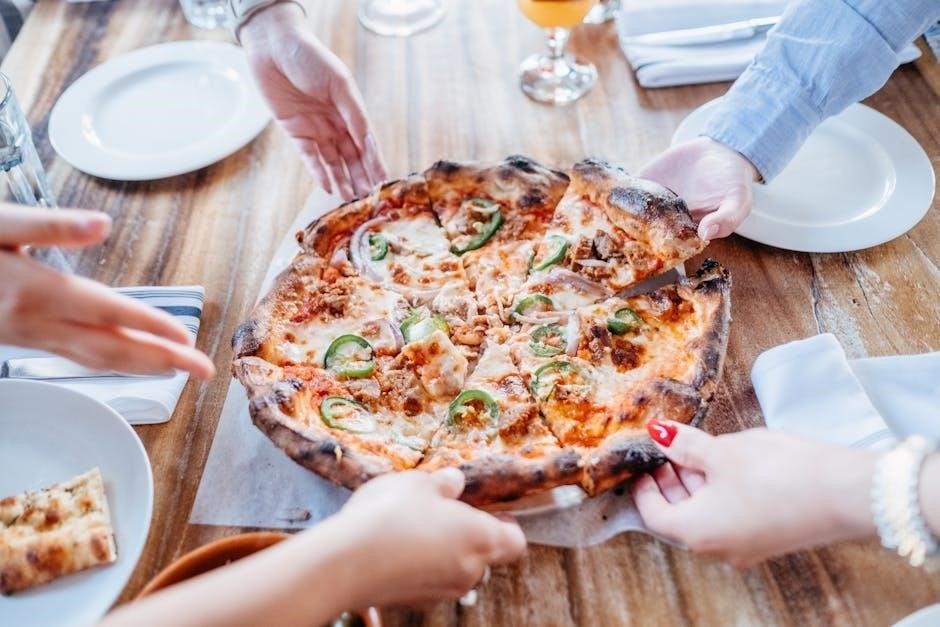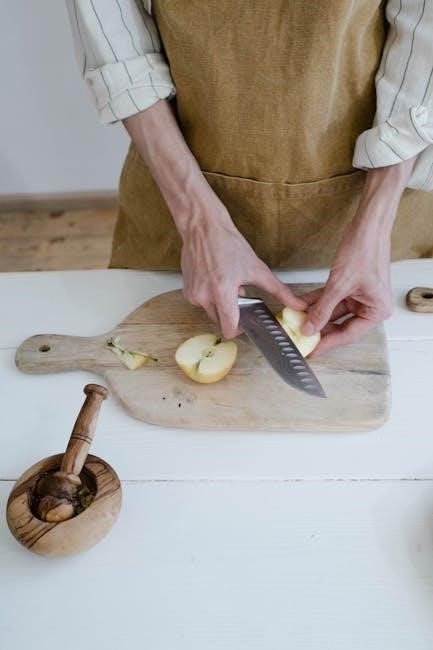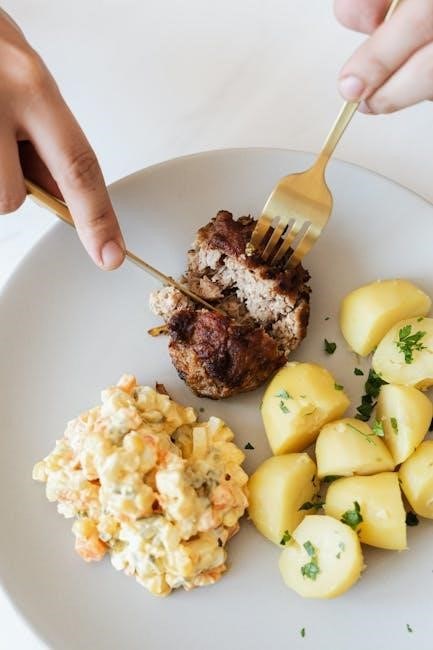A knife angle guide is a tool designed to help users maintain precise angles during knife sharpening, ensuring consistency and effectiveness. It is essential for both novice and experienced sharpeners, offering a straightforward way to achieve optimal edge retention and razor-sharp results. This guide is particularly useful for various knife types, from everyday carry knives to specialized culinary tools.
1.1 What is a Knife Angle Guide?
A knife angle guide is a tool designed to help maintain consistent sharpening angles for knives. It typically attaches to the knife or sharpening stone, ensuring precise angle control. This device is invaluable for achieving uniform edge geometry, preventing guesswork, and optimizing sharpness. It suits both novices and experts, offering a reliable method to enhance sharpening accuracy and consistency across various knife types.
1.2 Importance of Using a Knife Angle Guide
Using a knife angle guide ensures precise control over sharpening angles, preventing uneven edges and extending the knife’s life. It enhances consistency, especially for novices, and optimizes sharpness. Proper angles maintain the knife’s intended performance, whether for culinary or outdoor use. This tool is essential for achieving professional-level results and preserving the knife’s integrity through accurate sharpening techniques.
Understanding Sharpening Angles
Understanding sharpening angles involves recognizing the precise degree measurements that affect a knife’s performance. Common angles range between 15° to 30°, impacting edge sharpness and durability.
2.1 The Concept of Sharpening Angles
Sharpening angles refer to the precise degree at which a knife’s edge is honed. Typically ranging from 15° to 30°, these angles determine the knife’s sharpness, durability, and suitability for specific tasks. A smaller angle yields a sharper edge, while a larger angle provides greater robustness. Understanding this balance is crucial for achieving optimal results in knife sharpening.
2.2 Common Sharpening Angles for Different Knives
Sharpening angles vary based on knife type and use. Straight-edge knives often use 20°, while serrated knives may require 22°-25°. Chef knives typically range from 18°-22°, balancing sharpness and durability. Hunting knives might use steeper angles (25°-30°) for robustness, ensuring optimal performance for their intended tasks. Understanding these standards helps in achieving the best results for each specific knife.

How to Choose the Right Angle
Choosing the right angle involves assessing the knife’s hardness, intended use, and edge geometry. Softer steels typically require steeper angles, while harder steels benefit from lower angles, optimizing sharpness and durability for specific tasks.
3.1 Determining the Optimal Angle for Your Knife
Determining the optimal angle involves considering the knife’s hardness, intended use, and edge geometry. Softer steels typically require steeper angles (25°-30°), while harder steels benefit from lower angles (15°-20°). This balance ensures sharpness, durability, and performance for specific tasks, whether culinary, outdoor, or everyday use.
3.2 Factors Influencing the Sharpening Angle
The primary factors influencing sharpening angles include blade hardness, bevel type, and intended use. Harder steels perform best at lower angles (15°-20°), while softer steels require steeper angles (25°-30°). Additionally, the knife’s edge geometry and desired sharpness level play a role. Straight-edge knives typically use symmetric angles, whereas serrated knives may require specialized techniques. Usage context, such as culinary or outdoor tasks, further tailors the ideal angle.
Tools for Maintaining the Correct Angle
Various tools like sharpening guides, angle markers, and adjustable clamps help maintain consistent angles. These devices ensure precision and are essential for achieving professional-level sharpness across different knife types.
4.1 Overview of Knife Sharpening Tools
Knife sharpening tools include guides, markers, and clamps, designed to assist in maintaining precise angles. These tools enhance control and consistency, ensuring optimal edge retention. Popular options like sharpening guides and adjustable clamps cater to various knife types, making the sharpening process efficient and precise for both novices and experienced users.
4.2 Using a Sharpening Guide or Angle Marker
A sharpening guide or angle marker ensures precise angle control during knife sharpening. It helps maintain consistency, reducing errors and enhancing edge sharpness. These tools are indispensable for achieving optimal results, especially for those refining their sharpening skills. They cater to various knife types, making the process efficient and precise for both novices and experienced users.

Step-by-Step Guide to Using a Knife Angle Guide
Using a knife angle guide involves preparing the knife, positioning it at the correct angle, and sharpening with consistent strokes. This ensures precision and effectiveness for optimal results.
5.1 Preparing Your Knife for Sharpening
Before sharpening, clean the knife blade to remove dirt or oil. Inspect the edge for nicks or damage. Secure the knife firmly, ensuring the bevel is accessible. Use the guide to align the knife at the desired angle. Proper preparation ensures a smooth sharpening process and consistent results, making the task safer and more effective for achieving a razor-sharp edge.
5.2 Positioning the Knife at the Correct Angle
Align the knife’s bevel with the guide, ensuring the blade is flat on the sharpening surface. Adjust the angle guide to match your desired angle, securing it firmly. Maintain consistent pressure and alignment as you sharpen, ensuring the edge stays precise. Proper positioning is key to achieving a sharp, durable edge, making the process efficient and effective for any knife type.
5.3 Sharpening Technique and Maintenance
Use light, consistent strokes along the sharpening surface, maintaining the correct angle. Check progress regularly by inspecting the edge. After sharpening, clean the knife and guide to remove debris. Store both in a dry place to prevent rust. Regular maintenance ensures longevity and optimal performance of your knife and angle guide.

Knife Types and Their Specific Angles
Knives vary in design, requiring specific sharpening angles. Straight-edge knives typically use 20° per side, while serrated knives may need specialized techniques. Angle choice depends on knife type and intended use.
6.1 Straight-edge vs. Serrated Knives
Straight-edge knives typically require a 20° angle per side for sharpness, while serrated knives need specialized techniques. Serrated edges often use a shallower angle for maintaining their unique tooth structure. The angle choice depends on the knife’s intended use, with straight-edge favoring precision and serrated focusing on cutting efficiency through tough materials.
6.2 Specialized Knives and Their Sharpening Requirements
Specialized knives, like hunting or fillet knives, often require tailored sharpening angles. Hunting knives may use a steeper angle (25°-30°) for durability, while fillet knives prefer a sharper angle (15°-20°) for precision. High-carbon steel knives benefit from lower angles to maintain sharpness, whereas serrated or curved knives need unique techniques to preserve their edge geometry and functionality. The angle guide ensures precise adjustments for these specific needs.
Advanced Sharpening Techniques
Advanced sharpening involves mastering custom edge geometry and variable angles, allowing for precise control over blade sharpness and durability. It requires skill and practice to refine techniques.
7.1 Freehand Sharpening Without a Guide
Freehand sharpening without a guide requires precision and practice, allowing for complete control over the sharpening process; It involves understanding the knife’s edge geometry and maintaining consistent angles manually. This technique demands patience and skill, as it relies on visual cues and tactile feedback. Mastery of freehand sharpening enables customization of the blade’s sharpness to specific needs or preferences, making it a valuable skill for enthusiasts and professionals alike.
7.2 Advanced Edge Geometry and Custom Angles
Advanced edge geometry involves tailoring the knife’s angle to specific tasks, optimizing performance for cutting techniques. Custom angles allow for precision adjustments, enhancing sharpness and durability. This method is ideal for specialized knives, such as high-carbon steel blades, where unique bevels improve functionality. Mastery of custom angles requires deep understanding of blade materials and intended use, enabling superior results for enthusiasts and professionals.

Common Mistakes to Avoid
Avoiding common mistakes like over-sharpening, incorrect angle placement, and inconsistent strokes is crucial. These errors can lead to a dull edge or reduced knife lifespan, emphasizing the need for careful technique and attention to detail during the sharpening process to ensure optimal results and maintain blade integrity effectively.
8.1 Over-sharpening and Under-sharpening
Over-sharpening can lead to a brittle edge prone to chipping, while under-sharpening results in a dull knife. Both mistakes stem from improper angle control or inconsistent strokes. Using a knife angle guide helps maintain the correct angle, preventing these issues. Regular practice and attention to the knife’s edge geometry are essential to avoid such common pitfalls and achieve a razor-sharp finish consistently.
8.2 Incorrect Angle Placement and Its Effects
Incorrect angle placement can lead to uneven edges, reduced sharpness, and a weaker blade. It may also cause the knife to become misshapen or develop wire edges. Proper use of a knife angle guide ensures consistent angles, preventing these issues. Regular practice and careful monitoring of the blade’s geometry are crucial to avoid such mistakes and maintain optimal knife performance over time.

Maintenance and Care of the Knife Angle Guide
Regular cleaning and storing in a dry place are essential. Check for damage and align properly to ensure accuracy and extend longevity.
9.1 Cleaning and Storing Your Sharpening Tools
Clean your knife angle guide and sharpening tools regularly to remove residue. Store them in a dry place to prevent rust. Check for damage and align the guide properly before use to ensure sharpening accuracy. Proper maintenance extends the life of both the knife and the guide, ensuring consistent results over time. Always handle tools with care to avoid scratches or misalignment.
9.2 Extending the Life of Your Knife and Guide
Regular cleaning prevents residue buildup, while storing in a dry place avoids rust. Proper alignment ensures the guide functions accurately. Sharpening at the correct angle maintains the knife’s edge. Handle both tools with care to avoid scratches or misalignment. Consistent maintenance and proper handling extend the life of your knife and guide, ensuring long-term precision and reliability in sharpening tasks.
The Future of Knife Sharpening Technology
Advancements in automation and AI promise to revolutionize knife sharpening, offering precise angle control and streamlined processes for novice and expert sharpeners alike, ensuring consistent results.
10.1 Innovations in Sharpening Guides
Modern sharpening guides now incorporate digital laser alignment and voice-assisted angle adjustments, enhancing precision. Some models feature app connectivity, offering real-time feedback and customizable settings. These innovations ensure effortless sharpening, catering to both professionals and hobbyists. Advanced materials and ergonomic designs further improve usability, making knife maintenance more efficient and accessible for all skill levels.
10.2 How Technology is Changing Sharpening Techniques
Technology is revolutionizing knife sharpening by introducing AI-powered angle guides, sensor-equipped sharpening stones, and automated systems. These tools provide real-time feedback, ensuring precise angles and consistent results. Smart sharpening devices now adjust automatically based on knife type and material, reducing errors and enhancing efficiency. This shift is making sharpening more accessible and effective for both professionals and enthusiasts alike.
A knife angle guide is an indispensable tool for achieving precise sharpening results. Consistent practice and proper technique ensure professional-quality edges, making it a must-have for enthusiasts and professionals.
11.1 Summary of Key Points
A knife angle guide is essential for maintaining consistent sharpening angles, ensuring optimal edge retention and sharpness. Proper angle selection, tool maintenance, and technique practice are critical for achieving professional-quality results. Understanding knife types, sharpening tools, and common mistakes helps refine skills. Regular practice and adherence to guidelines ensure long-lasting, razor-sharp blades for various applications.
11.2 Encouragement to Practice and Experiment
Consistent practice with a knife angle guide enhances sharpening skills and precision. Experiment with different angles and techniques to understand what works best for your knives. Don’t be discouraged by initial setbacks—each attempt refines your mastery. Sharpening is a skill that improves with patience and dedication, leading to sharper, more reliable blades for years to come.

Additional Resources
Explore recommended books, online tutorials, and forums for deeper insights into knife sharpening. Online communities and specialized websites offer valuable tips and expert advice.
12.1 Recommended Reading and Tutorials
For in-depth learning, explore books like The Art of Knife Sharpening and online tutorials on platforms like YouTube. Websites such as KnifeSharpeningGuide.com offer step-by-step videos and articles. Forums like BladeForums.com provide expert advice and user experiences. These resources cover basic to advanced techniques, ensuring you master the knife angle guide and sharpening process effectively.
12.2 Online Communities and Forums
Engage with online forums like BladeForums.com, Reddit’s r/knives, and specialized Facebook groups. These communities offer interactive discussions, troubleshooting, and expert advice on knife angle guides; Members share tips, personal experiences, and resources, making them invaluable for learning and refining sharpening techniques. Active participation can enhance your skills and provide access to a wealth of shared knowledge and resources.
Final Thoughts
Consistency is key to mastering knife sharpening. A knife angle guide simplifies the process, ensuring precise results. Regular practice enhances skill, making sharpening a rewarding hobby and essential skill.
13.1 The Importance of Consistency in Sharpening
Consistency in sharpening is crucial for achieving a razor-sharp edge. It ensures uniformity in the blade’s edge geometry, leading to better performance and durability. By maintaining the same angle each time, you preserve the knife’s integrity and functionality. This reliability is key for both everyday use and specialized tasks. A consistent approach enhances the overall sharpening experience, making it more efficient and effective.
13.2 Sharpening as a Skill and Hobby
Sharpening is more than a task; it’s a skill and hobby that requires patience and technique. Using a knife angle guide helps enthusiasts master precise angles, developing muscle memory and an understanding of edge geometry. For many, sharpening becomes an art form, offering satisfaction and a sense of accomplishment. It fosters a deeper appreciation for the craftsmanship behind every blade.